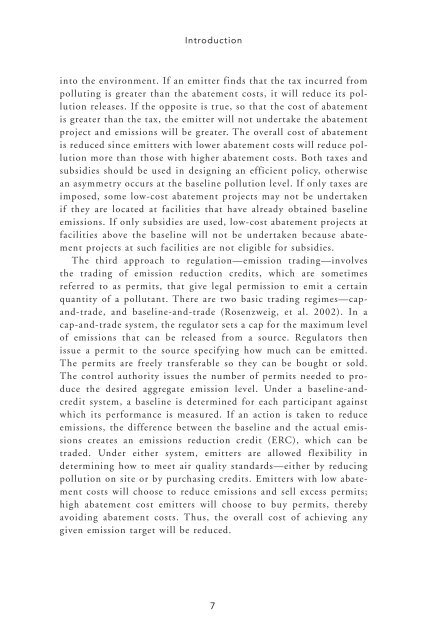Entire Book - Southwest Consortium for Environmental Research ...
Entire Book - Southwest Consortium for Environmental Research ...
Entire Book - Southwest Consortium for Environmental Research ...
You also want an ePaper? Increase the reach of your titles
YUMPU automatically turns print PDFs into web optimized ePapers that Google loves.
Introduction<br />
into the environment. If an emitter finds that the tax incurred from<br />
polluting is greater than the abatement costs, it will reduce its pollution<br />
releases. If the opposite is true, so that the cost of abatement<br />
is greater than the tax, the emitter will not undertake the abatement<br />
project and emissions will be greater. The overall cost of abatement<br />
is reduced since emitters with lower abatement costs will reduce pollution<br />
more than those with higher abatement costs. Both taxes and<br />
subsidies should be used in designing an efficient policy, otherwise<br />
an asymmetry occurs at the baseline pollution level. If only taxes are<br />
imposed, some low-cost abatement projects may not be undertaken<br />
if they are located at facilities that have already obtained baseline<br />
emissions. If only subsidies are used, low-cost abatement projects at<br />
facilities above the baseline will not be undertaken because abatement<br />
projects at such facilities are not eligible <strong>for</strong> subsidies.<br />
The third approach to regulation—emission trading—involves<br />
the trading of emission reduction credits, which are sometimes<br />
referred to as permits, that give legal permission to emit a certain<br />
quantity of a pollutant. There are two basic trading regimes—capand-trade,<br />
and baseline-and-trade (Rosenzweig, et al. 2002). In a<br />
cap-and-trade system, the regulator sets a cap <strong>for</strong> the maximum level<br />
of emissions that can be released from a source. Regulators then<br />
issue a permit to the source specifying how much can be emitted.<br />
The permits are freely transferable so they can be bought or sold.<br />
The control authority issues the number of permits needed to produce<br />
the desired aggregate emission level. Under a baseline-andcredit<br />
system, a baseline is determined <strong>for</strong> each participant against<br />
which its per<strong>for</strong>mance is measured. If an action is taken to reduce<br />
emissions, the difference between the baseline and the actual emissions<br />
creates an emissions reduction credit (ERC), which can be<br />
traded. Under either system, emitters are allowed flexibility in<br />
determining how to meet air quality standards—either by reducing<br />
pollution on site or by purchasing credits. Emitters with low abatement<br />
costs will choose to reduce emissions and sell excess permits;<br />
high abatement cost emitters will choose to buy permits, thereby<br />
avoiding abatement costs. Thus, the overall cost of achieving any<br />
given emission target will be reduced.<br />
7









